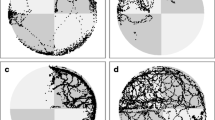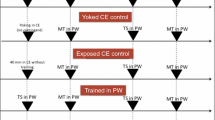Abstract
Goldfish treated by immersion with the drug piracetam (SKF 38462 or UCB 6215) in their home tanks obtained higher mean levels of correct active dark-avoidance responding than non-drug-treated controls; the difference did not emerge until the last two days of the five days of training. In another experiment, fish immersed in the drug solution before a single session of group training for dark avoidance scored more correct responses during retention testing than fish exposed to only water before training. However, no difference in correct retention responding was found between fish exposed, during the interval between training and testing, to the drug solution and fish exposed to only water. General activity during retention testing was unaffected with respect to pretraining immersion in water or drug solution; however, immersion in the drug solution between training and testing resulted in lower levels of general activity during retention testing.
Similar content being viewed by others
References
Abramowitz, M., Segun, I. A.: Handbook of Mathematical Functions, p. 944. New York: Dover 1965.
Agranoff, B. W., Davis, R. E.: The use of fishes in studies on memory formation. In: The Central Nervous System and Fish Behavior, D. J. Ingle, ed., pp. 193–201. Chicago: University of Chicago Press 1968.
Belleville, E. R.: Control of behavior by drug-produced internal stimuli. Psychopharmacologia (Berl.) 5, 95–105 (1964).
Braud, W. G.: The goldfish as a subject for psychological and physiological research. J. Biol. Psychol. 12, 61 (1970).
Bryant, R. C.: Transfer of light-avoidance tendency in groups of goldfish by intracranial injection of brain extract. J. Biol. Psychol. 13, 19–24 (1971).
Bryant, R. C., Santos, N. N., Byrne, W. L.: Synthetic scotophobin in goldfish: specificity and effect on learning. Science 176, 635–636 (1972).
Cochran, W. G., Bliss, C. I.: Analysis of variance. In: Statistics in Endocrinology, J. W. McArthur and Theodore Colton, eds., pp. 33–78. Cambridge, Mass: MIT Press 1970.
Cutting, W., Baslow, M., Read, D., Furst, A.: The use of fish in the evaluation of drugs affecting the central nervous system. J. clin. exp. Psychopath. 20, 26–32 (1959).
Fjerdingstad, E. J.: Memory transfer in goldfish. J. Biol. Psyohol. 11, 20–25 (1969).
Giurgea, C., Lefevre, D., Lescrenier, C., David-Remacle, M.: Pharmacological protection against hypoxia induced amnesia in rats. Psychopharmacologia (Berl.) 20, 160–168 (1971).
Giurgea, C., Mouravieff-Lesuisse, F.: Effect facilitateur du piracetuam sur un apprentissage repetitif chez le rat. J. Pharmacol. (Paris) 3, 17–30 (1972).
Giurgea, C., Moyersoons, F., Evraerd, A. A.: GABA-related hypothesis on the mechanism of action of the antimotion sickness drugs. Arch. int. Pharmacodyn. 166, 379–387 (1967).
Ingle, D. J.: The use of the fish in neuropsychology. Perspect. Biol. Med. 8, 241–260 (1965).
Levy, G., Gucinski, S.: Studies on biologic membrane permeation kinetics and acute toxicity of drugs be means of goldfish. J. Pharmacol. exp. Ther 146, 80–86 (1964).
Moyersoons, F., Evraerd, W., Dauby, J., Giurgea, C.: A particular pharmacological effect on the propagation of experimental strychnine and penicillin epilepsy. Arch. int. Pharmacodyn. 179, 388–400 (1969).
Overton, D. A.: State-dependent learning produced by depressant and atropine-like drugs. Psychopharmacologia (Berl.) 10, 6–31 (1966).
Ryback, R. S., Percarpio, B., Vitale, J.: Equilibrium and metabolism of ethanol in the goldfish. Nature (Lond.) 222, 1068–1070 (1969).
Sara, S. J., Lefevre, D.: Hypoxia-induced amnesia in one-trial learning and pharmacological protection by piracetam. Psychopharmacologia (Berl.) 25, 32–40 (1972).
Wolthuis, O. L.: Experiments with UCB 6215, a drug which enhances acquisition in rats: its effects compared with those of metamphetamine. Europ. J. Pharmacol. 16, 283–297 (1971).
Author information
Authors and Affiliations
Additional information
This work was supported in part by the Tennessee Department of Mental Health; by a General Research Support Fellowship from the University of Tennessee College of Medicine (to RCB); and by a National Institutes of Health Fellowship No. 1 FO2 GM51238-01-NIGMS (to FP).
Rights and permissions
About this article
Cite this article
Bryant, R.C., Petty, F. & Byrne, W.L. Effects of piracetam (SKF 38462) on acquisition, retention, and activity in the goldfish. Psychopharmacologia 29, 121–130 (1973). https://doi.org/10.1007/BF00422644
Received:
Issue Date:
DOI: https://doi.org/10.1007/BF00422644




